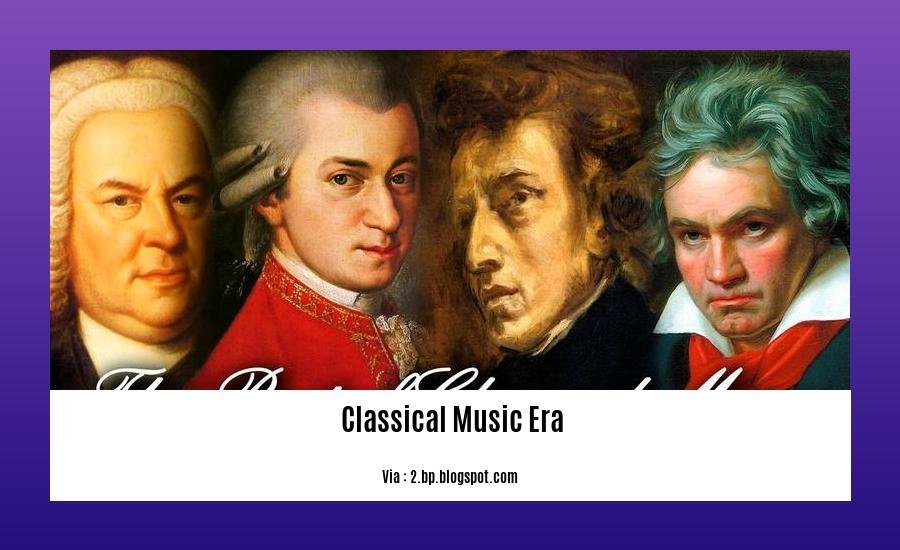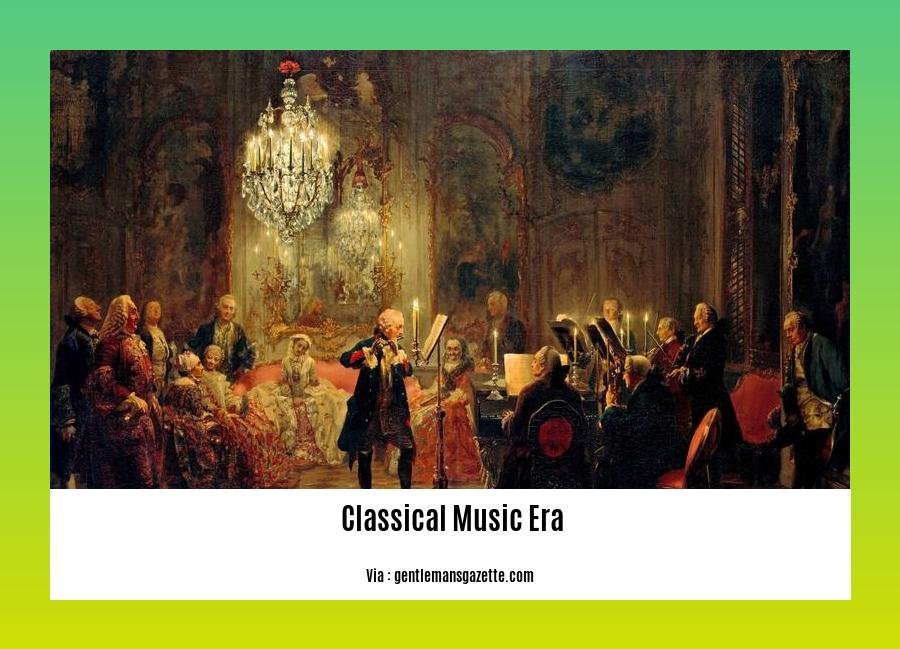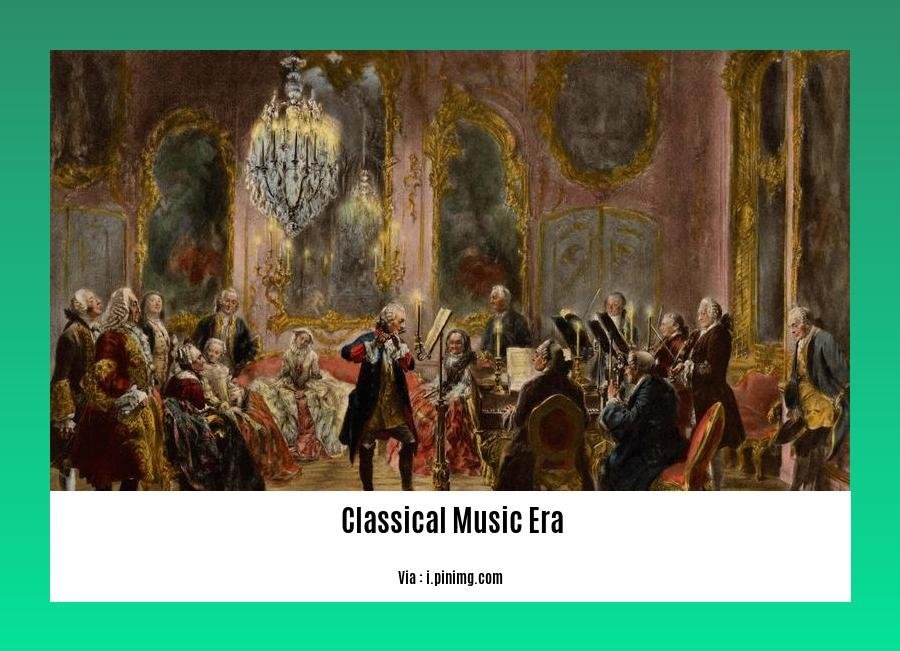Prepare yourself for a captivating odyssey through the annals of musical history in [A Journey Through the Epochs: The Evolution of Classical Music Era]. Delve into the golden age of composition, where maestros such as Mozart, Beethoven, and Bach shaped the very essence of what we know as classical music. Unravel the threads that connect each era, from the Baroque’s intricate melodies to the Romantic’s expressive outpourings and beyond. Let us embark on this enchanting exploration of an era that continues to captivate and inspire generations.
Key Takeaways:
- Classical music era spanned from ~1750-1820.
- Shift towards simpler textures and contrasting rhythms.
- Influenced by Neoclassicism, emphasizing order and balance.
- Increased orchestra size for a bolder sound.
- Move from Baroque polyphony to homophonic style (melody over harmony).
The Classical Music Era: A Journey Through Refinement and Elegance

The classical music era emerged as a transitional period between the Baroque and Romantic eras, spanning roughly from 1750 to 1820. It ushered in a shift towards a lighter, more transparent musical style, paving the way for the dramatic expressions of the Romantic period.
Characteristics of the Classical Era
Clarity and Simplicity: The classical music era emphasized order and balance, moving away from the complex polyphony of the Baroque era. Melodies became more concise and phrases were contrasted with contrasting rhythms.
Homophony: Homophony, where a single melody is supported by subordinate harmonies, became the dominant texture. This allowed for a clearer presentation of musical ideas.
Dynamics and Expression: Dynamic contrasts were more nuanced, ranging from soft (piano) to loud (forte). Composers explored expressive qualities through dynamic shading and articulation.
Increased Orchestra Size: Orchestras grew in size, incorporating a wider range of instruments, including clarinets, trumpets, and timpani. This allowed for a more powerful and varied sound.
Historical Context
The classical music era coincided with the Enlightenment and the rise of Neoclassicism. Society placed a high value on reason, order, and the study of the ancient world. These ideals influenced the musical style of the time, resulting in a focus on clarity, balance, and simplicity.
Notable Composers
The classical music era produced a constellation of renowned composers, including:
- Wolfgang Amadeus Mozart
- Ludwig van Beethoven
- Joseph Haydn
- Franz Schubert
Each of these composers made significant contributions to the development of the classical music era, expanding its expressive possibilities and leaving an enduring legacy on the musical world.
Learn about the history of music, and how musical symbols evolved throughout history in the fascinating development of musical notation. Immerse yourself in the vibrant world of modern music genres to expand your musical horizons.
Major Composers and Works of the Classical Era

Oh, the joys of classical music! This enchanting genre, bursting with grace and sophistication, has us humming along to its timeless melodies. But let’s delve into the era that laid the foundation – the Classical Era.
Key Takeaways:
- The Classical Era stretched from 1750 to 1820, connecting the Baroque and Romantic periods.
- Clarity, simplicity, and dynamic contrasts define the essence of this era.
- Wolfgang Amadeus Mozart, Ludwig van Beethoven, Joseph Haydn, and Franz Schubert were the maestros who shaped its destiny.
Wolfgang Amadeus Mozart:
– The child prodigy, Mozart, left an indelible mark with operas like “The Marriage of Figaro” and symphonies like “Jupiter.”
Ludwig van Beethoven:
– Beethoven, a titan of the Classical Era, ushered in the Romantic Era with his path-breaking symphonies like “Eroica” and “Ninth.”
Joseph Haydn:
– The father of the symphony, Haydn’s works, such as the “Surprise” Symphony, showcase his mastery of classical forms.
Franz Schubert:
– Schubert’s works, including “Unfinished Symphony,” bridge the gap between the Classical and Romantic eras.
The Major Composers and Works of the Classical Era continue to captivate audiences today. These maestros pushed the boundaries of music, creating masterpieces that transcend time. So, let’s raise a glass to the Classical Era and its enduring legacy!
Most Relevant URL Sources
– The Classical Music Period: An Overview
– 10 of the best Classical era composers
Social and Cultural Factors Influencing Classical Music
The Rise of the Middle Class and the Enlightenment
During the Classical Era, the middle class expanded and gained wealth, fueling a demand for music that was more entertaining and accessible than the complex works of the Baroque Era. They favored melodies that were easier to hum and harmonies that were more pleasing to the ear. The Enlightenment, with its emphasis on reason and order, further influenced the clear and balanced structures of Classical Era music.
Economic Changes and the Development of Public Concerts
Economic prosperity led to the establishment of concert halls, providing a dedicated space for musical performances. Public concerts became a popular form of entertainment, allowing composers to reach a broader audience and showcase their works. This spurred competition among musicians and composers, leading to innovative and compelling creations.
The Influence of Salons
Salons, private gatherings hosted by aristocrats and wealthy patrons, became important incubators for musical talent. Composers would perform their works in these intimate settings, receiving feedback and patronage from influential individuals. Salons fostered a conducive environment for experimentation and creative exchange.
Key Takeaways:
- The rise of the middle class and the Enlightenment shaped the demand for more accessible and entertaining music.
- Economic prosperity and the establishment of concert halls facilitated the development of public concerts and showcased musical talent.
- Salons provided a nurturing space for musical experimentation and patronage.
Relevant URL Sources:
* Music and Society in the Classical Era – Springer
* The Classical Music Period: An Overview – Hello Music Theory
Legacy and Impact of the Classical Music Era
Key Takeaways:
- The Classical Music Era significantly shaped the development and appreciation of music, bridging the Baroque and Romantic eras.
- Composers like Mozart, Beethoven, and Haydn pioneered new musical forms and techniques that continue to inspire.
- Innovations in musical instruments expanded the range and expressiveness of classical music.
- The establishment of public concerts and venues fostered a wider audience for classical performances.
- Classical music’s influence extends beyond the concert hall, impacting film, television, and popular culture.
The Classical Music Era left an enduring legacy on music and society:
Established a Canon of Great Composers: The works of Mozart, Beethoven, Haydn, and others became foundational for Western music and are still performed and studied today.
Advanced Musical Forms and Techniques: Classical composers developed new forms like the symphony, concerto, and sonata, as well as harmonic and melodic structures that became standard in Western music.
Expanded Orchestral Capabilities: The increased use of instruments like the clarinet, trumpet, and timpani expanded the range and power of classical orchestras.
Inspired Subsequent Musical Eras: The Classical Era laid the groundwork for the Romantic and Impressionist eras, influencing composers like Schubert, Schumann, and Debussy.
Influenced Modern Culture: Classical music continues to be used in film, television, and video games, enriching the soundtracks of our lives.
Citation
- The Classical Music Period: An Overview – Hello Music Theory
- 10 of the best Classical era composers
FAQ
Q1: What are the key characteristics of music from the Classical era?
A1: Lighter, clearer texture, use of contrasting melodic figures and rhythms, emphasis on homophony, and larger orchestras.
Q2: Which composers were significant contributors to the Classical era?
A2: Wolfgang Amadeus Mozart, Ludwig van Beethoven, Joseph Haydn, and Carl Philipp Emmanuel Bach.
Q3: How did social and cultural factors influence the development of Classical era music?
A3: The rise of the middle class and the Enlightenment led to a demand for more entertaining and accessible music, and the establishment of public concerts fostered the growth of instrumental music.
Q4: What distinguishes Classical era music from the Baroque and Romantic eras?
A4: Classical era music is characterized by its elegance, balance, and simplicity, while Baroque music is more ornate and dramatic, and Romantic music is more passionate and emotional.
Q5: How did the evolution of musical instruments impact the sound of Classical era music?
A5: The increased use of larger orchestras, including the Baroque guitar, contributed to a more powerful and resonant sound in Classical era music.
















